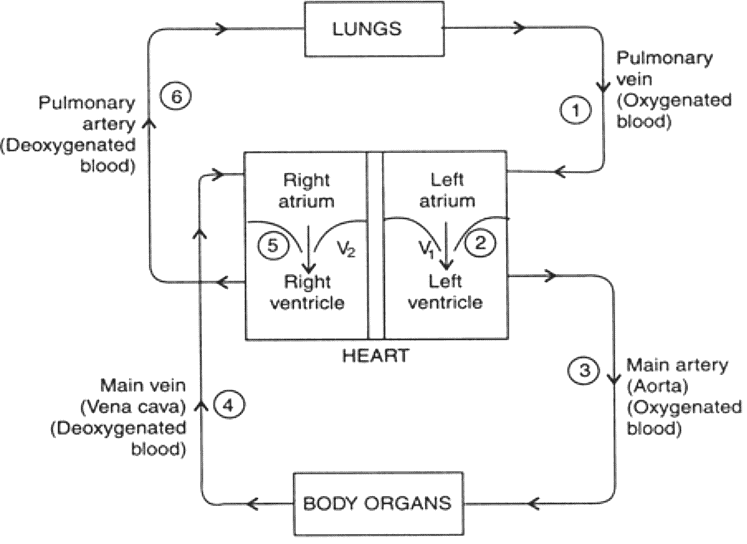Circulatory System | Famous Books for UPSC Exam (Summary & Tests) PDF Download
The Heart: The Mighty Pump
At the center of the circulatory system lies the heart, a powerful organ responsible for propelling blood throughout our bodies. With its triangular shape and composed of a special muscle known as cardiac muscle, the heart exhibits four chambers called atria and ventricles. The atria receive blood from the main veins, while the ventricles transport blood to the body and lungs. Intricate valves, such as V1 and V2, prevent the backflow of blood, ensuring a unidirectional flow and enabling the heart to effectively pump blood.
Arteries, Veins, and Capillaries: The Vital Pathways
The circulatory system's pathways are comprised of three types of blood vessels: arteries, veins, and capillaries. Arteries, possessing thick walls, carry blood from the heart to all parts of the body under high pressure. The main artery, called the aorta, connects to the left ventricle and efficiently distributes oxygenated blood throughout the body, except for the lungs. On the other hand, the pulmonary artery, linked to the right ventricle, transports deoxygenated blood exclusively to the lungs for oxygenation.
Capillaries, delicate and narrow tubes, form a vital link between arteries and veins. These microscopic vessels facilitate the exchange of essential materials, including oxygen, nutrients, and waste products, between the blood and body cells. Capillaries join with wider tubes known as veins, which have thinner walls since they carry blood at a lower pressure. To ensure one-way flow back to the heart, veins contain valves, distinguishing them from arteries. Veins play a crucial role in returning deoxygenated blood from various body organs to the heart.
Blood: The Life-Giving Fluid
Blood, a vibrant and life-sustaining fluid, is a fundamental component of the circulatory system. It carries essential substances, such as oxygen, digested food, hormones, and various chemicals, to all cells within the body. Additionally, blood acts as a carrier, collecting waste products like carbon dioxide from the body cells and eliminating them. Through its continuous circulation, blood tirelessly nourishes our organs and tissues, supporting our overall well-being.
The Process of Blood Circulation
- The circulation of blood follows a complex yet synchronized pathway within the human body. The journey begins as oxygenated blood is brought from the lungs to the left atrium of the heart through the pulmonary vein. Contraction of the left atrium propels the oxygenated blood into the left ventricle through valve V1. The subsequent contraction of the left ventricle forcefully propels the oxygenated blood into the aorta, which branches out to supply various organs. As blood travels through smaller arteries called arterioles, it eventually reaches the capillaries, where vital exchanges occur between the blood and body cells.

- After supplying oxygen and nutrients to the cells, blood becomes deoxygenated and laden with waste products. Deoxygenated blood from the body organs enters the main vein, known as the vena cava, which carries it back to the heart's right atrium. Contraction of the right atrium pushes the deoxygenated blood into the right ventricle through valve V2. Finally, the right ventricle contracts, sending deoxygenated blood to the lungs via the pulmonary artery. In the lungs, carbon dioxide is released, while fresh oxygen is absorbed, rejuvenating the blood. This oxygenated blood then returns to the left atrium via the pulmonary vein, ready to embark on another vital circulation throughout the body.
The Symphony of Heartbeats and Blood Pressure
- Heart Beats: A complete cycle of contraction and relaxation of the heart is referred to as a heartbeat. Under normal resting conditions, the average adult heart beats approximately 70 to 72 times per minute. To monitor this rhythmic symphony, doctors employ a stethoscope, enabling them to listen to the heart's melodic cadence. During exercise or strenuous activity, the heart beats faster to meet the increased energy demands of the body.
- Blood Pressure: The force exerted by the heart to pump blood throughout the body is known as blood pressure. It is measured using a device called a sphygmomanometer. Blood pressure readings consist of two values: systolic pressure and diastolic pressure. The systolic pressure represents the maximum pressure when blood leaves the heart during the contraction phase, while the diastolic pressure signifies the minimum pressure in the arteries during the relaxation phase. A healthy blood pressure reading is typically around 120/80 mm Hg.
Double Circulation: Pulmonary and Systemic
The circulatory system exhibits a remarkable feat known as double circulation, whereby blood travels through the heart twice within one complete body cycle. This process is divided into two pathways: pulmonary circulation and systemic circulation. Pulmonary circulation describes the journey of blood from the heart to the lungs and back, enabling the exchange of oxygen and carbon dioxide. Systemic circulation encompasses the flow of blood from the heart to the rest of the body, delivering oxygen, nutrients, and other vital substances while collecting waste products.
Conclusion
The human circulatory system is an awe-inspiring network, orchestrating the harmonious flow of blood and vital materials throughout our bodies. Through the heart's powerful beats, the intricate pathways of arteries, veins, and capillaries, and the ceaseless vitality of blood, this remarkable system ensures our survival and sustenance. By unraveling the mysteries of this extraordinary journey, we gain a deeper appreciation for the remarkable intricacies that keep us alive and thriving.
|
743 videos|1444 docs|633 tests
|
















